
Guests
- Video reportProduced by Franklin López & Dawn Paley from the Vancouver Media Co-op; with additional footage from Brandon Jourdan.
Canadian police have arrested over 600 people in Toronto in a police crackdown on protests at the G20 summit. Riot police used batons, plastic bullets and tear gas for the first time in the city’s history. More than 19,000 security personnel were deployed in Toronto, and a nearly four-mile-long security wall was erected around the G20 summit site at the Toronto Convention Center. The security price tag for the summit is estimated at around $1 billion. Franklin Lopez of the Vancouver Media Co-op filed this report from the streets of Toronto. [includes rush transcript]
Transcript
AMY GOODMAN:
Canadian police have arrested nearly 600 people in Toronto in a police crackdown on protests at the G8/G20 summit. Riot police used batons, plastic bullets, tear gas for the first time in the Toronto’s history. President Obama and world leaders gathered in Toronto for the summit following the gathering at Huntsville for the G8 talks. More than 19,000 security personnel were deployed in Toronto, and a nearly four-mile-long security wall was erected around the G20 summit site at the Toronto Convention Center. The security price tag for the summit is estimated at around one billion dollars.
Thousands of activists in Toronto held marches and demonstrations in the days leading up to the summits. Franklin López of the Vancouver Media Co-op filed this report from the streets of Toronto.
FRANKLIN LÓPEZ: Over the past month, Toronto has transformed from Canada’s biggest city to a veritable fortress. But over one billion dollars spent to protect the leaders of the G8 and G20 nations wasn’t enough to deter Torontonians and people from around the world from being in the streets doing a week of action against the G20 meetings. Here’s Edgar Godoy, a Guatemalan living in Toronto.
EDGAR GODOY: [translated] It’s difficult to mobilize in the city. There are restricted areas. And it’s a shame that the Harper government is investing $1.2 billion in security, when we have huge needs to be filled, like poverty, like student debt, the need to look after the earth and to build homes for the poor.
FRANKLIN LÓPEZ: Even with all the security, protest got underway well before the summits began. On Monday, hundreds of people gathered and marched through the city, briefly occupying an Esso gasoline station.
PROTESTER: Well, we’re occupying it in solidarity with the folks who are resisting the G8/G20. The police have been cracking down on us all afternoon. So we ducked in here, and we’re holding it for as long as we can.
FRANKLIN LÓPEZ: This marked the start of a full week of diverse resistance to the G8 and G20 summits held in Ontario. But instead of just organizing an anti-G20 convergence, people in Toronto worked hard to ensure that the messages of resistance came from community members across the city. Syed Hussan from the Toronto Community Mobilization Network explains.
SYED HUSSAN: Our focus has always been on building community power. In particular, we’ve done that by holding community forums, free barbecues, free lunches and dinners. We’ve been going into immigrant communities. We’ve been going into shelters. We’ve been going into welfare lines, waiting, talking to people. And this is a dual process. We’re not just saying, “Hey, come to the demonstration.” We’re saying, “What are your issues? What are your concerns?” How can we actively work to challenge them, that includes a protest, that includes a forum, that includes a direct action at their work or at their landlord’s house?
FRANKLIN LÓPEZ: On Tuesday, radical queers and disability activists owned the streets of Toronto, pulling off a spectacular demonstration against the increasingly negative state policies against gays, lesbians, gender benders and blenders. Hundreds of dancers, lovers and marchers denounced barriers against queer migrants, the corporatization of the pride parade, and increasing discrimination against gay people. Ro Velasquez from the Queer Resistance Network was one of the many who spoke out.
RO VELASQUEZ: Queer people are people of color. Queer people are criminalized every day by police brutality. Queer people are not let into this country because of their gender and their immigration status. Queer people are poor, with disabilities.
FRANKLIN LÓPEZ: The next morning, crowds led a toxic tour of Toronto, stopping along the way to speak out against the banks and corporations wreaking environmental and climate havoc around the world. One of the key targets of the march was the Royal Bank of Canada, a major financier of the Alberta tar sands. Here’s Mel Bazil from the Wet’suwet’en Nation.
MEL BAZIL: Right now we’re organizing against pipelines they propose to cross our territories, to Kitimat from Summit Lake. They would contain 525,000 barrels of oil, dirty oil, per day. And that amounts to seven pipelines. That looks at about 1,500 tankers per year.
FRANKLIN LÓPEZ: The Royal Bank of Canada, together with Suncor, a corporation devoted to extracting tar sands oil, were part of a select group of corporations that participated in the first-ever G20 business summit, where corporate heads sat down with G20 finance ministers in the days preceding the main event. As people marched, dozens of undercover police made their presence felt on the street.
CAMERAMAN: What’s your badge number? What is your badge number, sir?
UNDERCOVER POLICEMAN: Get that thing out of my face.
PROTESTER: What’s your badge number?
UNDERCOVER POLICEMAN: Get it out of my face!
CAMERAMAN: Don’t touch my camera, dude. Don’t touch my camera.
UNDERCOVER POLICEMAN: Get it out of my face.
PROTESTER: What’s your badge number?
UNDERCOVER POLICEMAN: Get that out of my face.
FRANKLIN LÓPEZ: Demonstrations continued to grow as the week went on. On Thursday, people gathered on a march led by indigenous peoples and followed by thousands of supporters. Art Manuel from the Secwepemc Nation explained why indigenous people are resisting the G20.
ART MANUEL: They’re talking about how they’re going to consolidate wealth and power for their own countries and the companies that exist in them. And we’re not for that. What we’re for is for more locally based, recognized economies.
FRANKLIN LÓPEZ: As the march snaked through the city of Toronto, crowds chanted “No G20 on stolen Native land!” reminding passersby that the city is built on the territory of the Mississauga people. Friday, as G8 presidents sat down in Huntsville, Ontario, over 4,000 people from all over Toronto came out for a march called Justice for Our Communities. Police attempted to enforce mandatory searches and to prevent those attending the march from bringing in picket signs and banners. But people refused to be intimidated and instead took over Allan Gardens, serving food, making music and dancing. Here’s Genevieve DeGuire explaining why she’s protesting the G20.
GENEVIEVE DeGUIRE: [interpreted] I think that what G20 symbolizes is the control and power and decision making of the matrix of control that exists at these high-level meetings, whereas real information, the cultural, linguistic information, for example, that the deaf community has, a culture that’s outside that matrix of power, it’s never going to get into the matrix until the matrix is taken down.
FRANKLIN LÓPEZ: Organizers rejected Toronto’s claim to being the most diverse city that’s ever played host to the G20 and instead highlighted racism and discrimination in Canada. Organizer Mohan Mishra explains.
MOHAN MISHRA: Canada is trying to trumpet its diversity as a good thing for the G8 and G20, but when you actually look at what diversity means, when you look at the way that, for example, immigrant women of color earn 44 percent less than a white man, when you look at the poverty in immigrant communities right here in Toronto, you really — you see — you can see behind that diversity to the way that people of color, marginalized communities, poor people are really treated here in Canada.
FRANKLIN LÓPEZ: As the party moved from the park to the street, riot police made their presence felt, and tensions rose. Even though police beat and arrested a deaf man who was later denied an interpreter, demonstrators reclaimed the streets for nearly four hours before retiring to Allan Gardens for a block party in a tent city. Lisa Scofield explained the decision to erect tents in the park.
LISA SCOFIELD: The Canadian government is spending $1.2 billion on the G20 summit. And that money, when you calculate it, could have been spent on housing all 80,000 people who are currently without proper housing in the city of Toronto for over a year at the market rent.
FRANKLIN LÓPEZ: That evening, the first arrest was made under increased police powers, which allowed anyone walking within the fifteen feet of the six-kilometer-long G20 fence in downtown Toronto to show identification and submit to searches without warrants.
RALLY SPEAKER: Put people back to work and protect public-sector jobs.
FRANKLIN LÓPEZ: Students, teachers, trade unions, communists, queers, indigneous peoples and anarchists joined with groups of Tamils, Kashmiris, Iranians, Tibetans and Ethiopians to denounce the G20 and fight for freedom. A man named Francis marched carrying a coffin for democracy. Here’s why.
FRANCIS: Today, twenty people from the richest countries on earth will make decisions that will affect the whole planet. We must ask ourselves why only the richest countries decide for humanity? In my opinion, it is anti-democratic.
FRANKLIN LÓPEZ: As the march made its way through Toronto, people shouted slogans demanding land, freedom and self-determination. Marcher Ulises Garcia explained the long road of struggle that led to the mobilization.
ULISES GARCIA: [translated] They are creating mechanisms to take our natural resources away from us. This has been going on for 500 years, and now it happens with even more agility.
FRANKLIN LÓPEZ: Part way through the permitted march, a contingency of at least 1,000 kept their promise to break away and head towards the G20 fence. Police cars were burned, and corporate storefronts were smashed. Hip-hop artist Illogik explains.
ILLOGIK: We’re not targeting people; we’re targeting property. No people were targeted or hurt, only corporate property. No small businesses, just the corporations who are killing our planet. And that’s the important thing to remember. It’s not violence. They are the violent ones.
FRANKLIN LÓPEZ: In the hours that followed, demonstrators who gathered at Queen’s Park, a designated free speech zone, were violently arrested by riot police and police on horses. In this clip, independent journalist Brandon Jourdan is beaten down by riot cops.
RIOT COP: Get up! Get up! Get up! Get up! Get up!
FRANKLIN LÓPEZ: By midday Sunday, more than 560 people are reported to be detained. A lawyer representing arrestees said that people are being denied wholesale their rights. While G20 leaders talk behind high fences in downtown Toronto, the streets have been deemed unsafe for anyone who has resisted against the summit. At the time of filing this story, people are still speaking out, and arrests continue.
AMY GOODMAN: That report produced by Franklin López and Dawn Paley from the Vancouver Media Co-op, with additional footage from Brandon Jourdan.

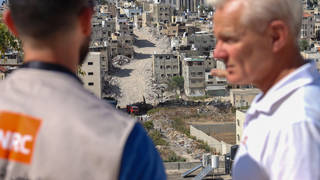
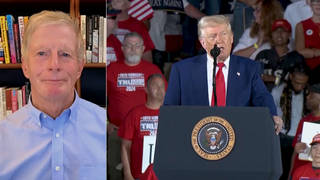
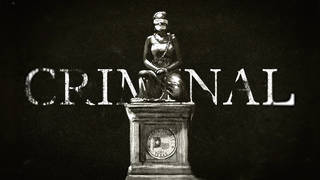
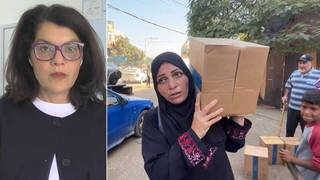





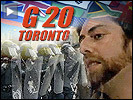
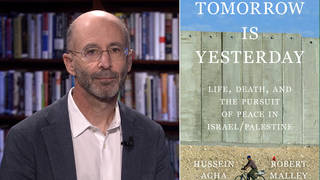
Media Options